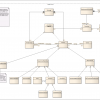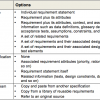 |
18 Questions to Ask for Better Backlog Refinement Refinement is time spent during the current sprint discussing and elaborating product backlog items so that they are ready for future sprints. Unfortunately, many teams do not unlock the full potential of refinement. Backlog items should be sliced, and a solution should be proposed, reviewed, and discussed. If your team is having trouble getting started, here are 18 questions you can use to trigger refinement discussions.
|
|
 |
Overcoming Challenges to Good Test Documentation Getting good test documentation is a consistent challenge. Agile proposes that you should go very light on documentation, and while test documentation does not need to be heavy, it does need to be clear and cover all that the product is intended to do so you can ensure testing is consistent and results are recorded. Here's how to overcome some major barriers to getting good test documentation.
|
|
 |
Eliminate Fake Certainty and Solve the Real Problem Too often, customers have a “fake certainty” about the problems they want to solve. They might not have defined the real problem, but they have frequently defined the solution anyway. The risk is that we might build the wrong thing. When the product owner works with the customers to define the problem, then works with the team to define the solution, everyone can win.
|
|
 |
Requirements Mapping Using Business Function Test Suites On this team, testers were overcommitted, avoidable defects were surfacing, and documentation was hard to find. Worse, trust and morale were low. Upgrading tools was out of the question, so the testers decided to take matters into their own hands and create incremental change themselves. Here's how a team added a new type of traceability to its requirement test case world.
|
|
 |
10 Lessons Learned in Cross-Platform Development Building an app for a single platform is difficult, but designing, implementing, and testing an app targeting multiple operating system platforms can be next to impossible. The secret balances upfront design with customer feedback.
|
|
 |
Requirements Reuse: Fantasy or Feasible? Software development teams think nothing about reusing code, but what about requirements? The benefits include faster delivery, lower development costs, consistency across and within applications, fewer defects, and reduced rework.
|
|
|
|
Lessons Learned from Ancient Wisdom: A Software Review Story Lessons learned long ago from reviews and inspection can be effective today, particularly in collaboration within agile teams. Learn how an organization used review techniques as part of its agile collaboration, including the advantages and potential problems of this ancient wisdom.
|
|
|
|
Simplicity and Precision: Test Planning in Agile Projects Test planning is often thought unnecessary in an agile project. However, if our mindset is on "planning" rather than "plans," we see that test-planning activities happen throughout the project, taking advantage of levels of precision, i.e., what is absolutely necessary at each level.
|
|
 |
The Essential Product Owner—Championing Successful Products: An Interview with Ellen Gottesdiener
Video
In this interview, Ellen Gottesdiener talks about her presentation at Agile Development Conference and Better Software Conference West 2014, the importance of having context for requirements, good ways to set value considerations for requirements, and the common mistakes of product owners.
|
|
 |
Leverage Social Media for Requirements Gathering: An Interview with Stefano Rizzo
Podcast
Stefano Rizzo introduces the idea of using social media to encourage customers to get involved in the requirements gathering process. Learn how by introducing something that your customers are already contributing towards, you can capture the mood behind their true wants and needs.
|
|
 |
Responsibly "Right" Requirements: An Interview with Tim Lister
Video
Tim Lister explains how getting the right requirements the first time from your stakeholders may not be easy, but it can be done, and it's worth the effort. Learn how with clear expectations, communication, and integral development, products can be delivered on time and to everyone's satisfaction.
|
|
|
|
Traceability's Priceless Role in Agile: An Interview with William Gens William Gens sits down with Noel Wurst to describe "the art and science of traceability" ahead of his STAREAST session of the same name. Learn what makes traceability meaningful and such a valuable asset to projects, no matter how bad the requirements may seem to be.
|
|
 |
How to Ensure That Requirements Are Testable
Slideshow
Discover practical ways to plan and prepare for the work, to communicate with testers and analysts about what needs to be done, and to create requirements that are understandable to everyone.
|
Arnika Hryszko
|
 |
Managing BDD Automation Test Cases inside Test Management Systems
Slideshow
Behavior-driven development (BDD) has been around for a while and is here to stay. However, the added abstraction levels pose a technical problem for writing and managing tests. While BDD does a great job of marrying the nontechnical aspect of test writing to the technical flow of an application under test, keeping this information under source control becomes problematic. Frameworks such as JBehave, Cucumber, or Robot give subject matter experts that additional ability to write tests, but they are often restricted access from them; because people treat test cases as code, they get stored in source control repositories. Additionally, these given-when-then steps soon can grow to an extent where they are difficult to manage without an IDE, and nontechnical people lose interest. Using management tools, Max Saperstone shows how to manage these nontechnical steps and keep them in sync with the automaton in tools such as Git.
|
Max Saperstone
|
 |
Mission Critical Automation Testing
Slideshow
When critical subsystems fail, the resulting losses can be catastrophic. In the insurance industry, if premiums are miscalculated, defect costs can reach well over a million dollars. In this session, Mike Keith and Dom Nunley draw on their practical experience with insurance systems testing to provide an overview of combinatorial automation testing for high-risk backend system areas—i.e., features that absolutely must work correctly. They share a process for categorizing requirement risk levels to determine which requirements warrant combinatorial testing. Mike and Dom illustrate various combinatorial testing techniques such as N-FAT, N-Wise, and RANDOM, which can be used to automatically generate test cases. These methods are used to ensure coverage against risk while controlling the number of tests that run.
|
Mike Keith
|
 |
The Five Biggest Mistakes Your Team Is Making in Requirements Definition
Slideshow
Google pioneer Alberto Savoia offered this sage advice: Build the right "it" before you build It right. But few software companies take the time to define, much less build, the right "it." The problem starts with a poor requirements definition process. In this session, join Kathryn Campbell as she examines the five most common mistakes that software companies make during requirements definition—and how to avoid them. First Kathryn defines thinking too small as a huge problem and shows you how to broaden your perspectives. Next, she exposes being stuck in the past, with legacy systems maintaining too much control of our innovation. The third mistake is assuming too much about your customers. Kathryn shares guerrilla techniques for gathering rapid, inexpensive customer feedback at every stage of your requirements and design process.
|
Kathryn Campbell
|
Visit Our Other Communities
AgileConnection is a TechWell community.
Through conferences, training, consulting, and online resources, TechWell helps you develop and deliver great software every day.

